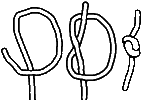After reading through all the threads relating to Ticks and Lyme Disease (especially the number of people on the forum who have had the misfortune of contracting this nasty disease) I thought it would be useful to post the latest reliable advice, relevant to the British Isles and Europe I have been able to find for safe removal of ticks. Hopefully this will help clarify the latest advice and debunk some of the older advice that is still sometimes given.
This information is from the EUCALB (European Union Concerted Action On Lyme Borreliosis) web site and is the central body co-ordinating efforts to understand and control Lyme Disease in Europe. There is a lot of information on the site, some of which is quite scientific, but provides an in depth look into this subject.
The first part is quoted directly from their site from the page entitled:
PREVENTION: Tick removal
Lyme Disease in Europe
Here is a simple illustration demonstrating how it is done:

If you are stuck without either a pair of tweezers or a proprietary tick removal tool (recommended. you can usually buy these cheaply from Veterinary Surgeries) then the recommended method of tick removal in the wild (as described above)is the 'cotton thread' or knotted method. Detail of this from the 'Wilderness Medical Society'
Wilderness Medical Society - The Knot Method of Tick Removal
Clearly described method with decent photo (click to enlarge)
You download the page as a PDF file (118 kb size) of the original article here
Just to clarify, this is a simple open overhand knot:

Finally you can check out the official advice and detail (diagnosis, prevention, treatment,symptoms etc) given from the NHS Direct web site here:
NHS Direct Online Health Encyclopaedia - Lyme disease
I have only covered tick removal here. Check the sources given for more information on prevention and what to do if you suspect you may have been infected.
Safe trekking
This information is from the EUCALB (European Union Concerted Action On Lyme Borreliosis) web site and is the central body co-ordinating efforts to understand and control Lyme Disease in Europe. There is a lot of information on the site, some of which is quite scientific, but provides an in depth look into this subject.
The first part is quoted directly from their site from the page entitled:
PREVENTION: Tick removal
They provide an illustrated online general information leaflet for further detail on the disease:PREVENTION: Tick removal
Points to Remember
If a tick is found attached to the skin do not panic. Even in areas where Lyme borreliosis (Lyme disease) is endemic, only a small proportion of ticks carry the disease and even then it usually takes up to 24 hours after attachment before transmitting the disease.
Remove the tick as soon as possible by grasping it with a pair of tweezers at the place where the tick's mouthparts are attached to the skin. Apply gentle pressure and pull upwards firmly and steadily. Clean the area around the bite with antiseptic disinfectant.
DO NOT
Panic.
Crush the tick's body.
Try to burn the tick off.
Apply petroleum jelly, nail polish or any other chemical (other than antiseptic).
DO
Use a pair of pointed tweezers. *
Cleanse bite site with antiseptic before and after removal.
Wash hands afterwards.
--------
* If a pair of tweezers is not available use a cotton thread rather than delay. Tie a single loop of cotton around the tick's mouthparts, as close to the skin as possible, then pull gently upwards and outwards.
If it is suspected that there may be mouth parts left in the skin, consult a doctor as this may result in local infection by other bacteria. Continue to check for a spreading red patch, especially one that appears between 3 and 30 days after removal of the tick. If symptoms develop in the days or weeks following the bite a doctor should be consulted as soon as possible. The risk of developing Lyme borreliosis from a tick bite is small, even in heavily infested areas, and most doctors prefer not to treat patients with antibiotics unless they develop symptoms.
Lyme Disease in Europe
Here is a simple illustration demonstrating how it is done:

If you are stuck without either a pair of tweezers or a proprietary tick removal tool (recommended. you can usually buy these cheaply from Veterinary Surgeries) then the recommended method of tick removal in the wild (as described above)is the 'cotton thread' or knotted method. Detail of this from the 'Wilderness Medical Society'
Wilderness Medical Society - The Knot Method of Tick Removal
Clearly described method with decent photo (click to enlarge)
You download the page as a PDF file (118 kb size) of the original article here
Just to clarify, this is a simple open overhand knot:

Finally you can check out the official advice and detail (diagnosis, prevention, treatment,symptoms etc) given from the NHS Direct web site here:
NHS Direct Online Health Encyclopaedia - Lyme disease
I have only covered tick removal here. Check the sources given for more information on prevention and what to do if you suspect you may have been infected.
Safe trekking

